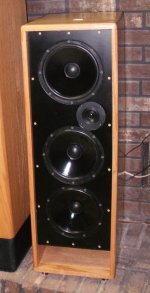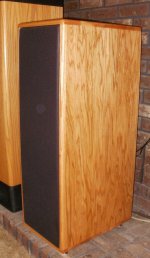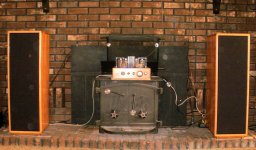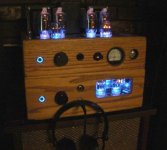Thanks for the feedback. It's really appreciated but I do have a couple of other questions.
What's "butcher block" construction?
What do you mean by "do it right"? What's the best way to float the hardwood?It would be better if it floats, and if you do it right you get constrained layer damping.
It is best if the solid material is actually a "butcher block" construction.
What's "butcher block" construction?
I can get the walnut resawn but is there any particular reason why hardwood thicker than 1/8" is not recommended for this application? Would using 1/2" or 3/4" walnut cause problems? The reason I ask is because I would like for these speakers to have rounded corners and the look that I'm going for won't be possible with veneer or 1/8" thick hardwood.Regardless of which you use, the common woodworkers method for working with solid wood over a panel is to resaw the hard wood (use a bandsaw) to a thickness of approx 3/16” (5 mm if you're metric) and then use a thickness planer or thickness sander to get it down to 1/8” (3 mm) which you then glue to the panel. With a box of .5 cu. ft. Your panel sizes won't be large enough to cause a problem. Use this method for all panels, and don't use sold for top and bottom and ply/MDF/hardwood composite panels for sides, front, back.
If you don't have access to a bandsaw, there may be a millwork shop in your area that can do it for you. They'll need an extended throat on the bandsaw and at least a half inch blade (¾ inch is better). With the right equipment, and someone who knows what they're doing, 8” wide, or wider, boards can easily be resawn. Virtually any hardwood can be resawn. I've done birds eye maple without a problem.
Thanks for the input.
I can get the walnut resawn but is there any particular reason why hardwood thicker than 1/8" is not recommended for this application? Would using 1/2" or 3/4" walnut cause problems? The reason I ask is because I would like for these speakers to have rounded corners and the look that I'm going for won't be possible with veneer or 1/8" thick hardwood.
Thanks for the input.
It is because the thickness of the hardwood directly relates to how much it will move (expand/contract). This is why it is ok to veneer to a manmade substrate (MDF, Plywood etc), the veneer is very thin. Anything much over an 1/8" (3mm) is prone to failure. Here is a movement calculator: Estimate Wood Movement Calculator
Keep in mind that wood moves perpendicular to the grain pattern. Thats why a board expands/contracts in width, not length. So you can build the shell of the box - top,bottom and sides out of solid wood just fine. Then make the baffle and backs out of a manmade material like MDF or ply.
If you do the reverse you will be screwed.
There can be expansion in the thickness on large pieces, but in my experience making gift boxes I have never had a failure this way.
I can get the walnut resawn but is there any particular reason why hardwood thicker than 1/8" is not recommended for this application? Would using 1/2" or 3/4" walnut cause problems? The reason I ask is because I would like for these speakers to have rounded corners and the look that I'm going for won't be possible with veneer or 1/8" thick hardwood.
Thanks for the input.
Easy. Veneer the panels, join with a rabbet (http://t2.gstatic.com/images?q=tbn:ANd9GcRZcZM4ftliDPLXjj9MjWvNdINyJgPNuQSq5mYc13HuNGfNetpW), then rout/saw part of the corner (3/8" probably reasonable if your rabbet was 3/4" deep and 3/8" wide), and glue in a solid piece of the same hardwood (grain will be perpendicular to the grain of the veneer). Once dry, round over the insert with a router. Depending on the wood, and the appearance, you may want to rout a very small V along the joint of the solid insert and the veneer.
What do you mean by "do it right"? What's the best way to float the hardwood?
We have yet to really determine that... but some solid over 15mm ply are in the planning stages... i can say it, but i can't do it, i leave that to Chris & Bernie.
dave
Thanks for the info. Here's a theoretical question regarding hardwood expansion: What would happen if 1/2" hardwood was glued to 3/4" MDF? Would the MDF move with the hardwood or would the glue fail?It is because the thickness of the hardwood directly relates to how much it will move (expand/contract). This is why it is ok to veneer to a manmade substrate (MDF, Plywood etc), the veneer is very thin. Anything much over an 1/8" (3mm) is prone to failure. Here is a movement calculator: Estimate Wood Movement Calculator
Keep in mind that wood moves perpendicular to the grain pattern. Thats why a board expands/contracts in width, not length. So you can build the shell of the box - top,bottom and sides out of solid wood just fine. Then make the baffle and backs out of a manmade material like MDF or ply.
If you do the reverse you will be screwed.
There can be expansion in the thickness on large pieces, but in my experience making gift boxes I have never had a failure this way.
Thanks for the info. Here's a theoretical question regarding hardwood expansion: What would happen if 1/2" hardwood was glued to 3/4" MDF? Would the MDF move with the hardwood or would the glue fail?
Tough to say, it depends on how wide the hardwood piece is. For example I am making some trim pieces now, and I will attach them to MDF sides. I am keeping them narrow. Plus I will only attach them in the middle so they can move, thats not really practical for what you are trying. Say a 4 inch by 8 inch piece... you could maybe get away with that, but a 14 x 18 would be a bad idea.
It is doubtful the glue will fail if you glued it properly, something else will give.. It might warp, or the hardwood could split. And sometimes it takes a while. I am helping a buddy with an old walnut chest, probably about 80 years old. Somewhere down the line, either originally or later, somebody laminated a 3/8 or so thick layer of walnut directly on the cedar, cross grain. Then it was in a damp area for a while, and the top just completely cut loose, warped all over the place.
Some things might last for 5-10 years and then you have a problem. Its sort of a question of how you want to build. I am weird because I build things to last until long after I am dead. That way either I don't have to worry about it, or if it is a clients they can't b#$# at me
BTW.. you bike?
Yes I do, strictly on the road, although I used to race on the track.BTW.. you bike?
Christmas stocking stuffers from the elven work shop. Solid top and bottom alternating grain, with 1/4" 9ply mahogany plywood laminated to the bottoms to prevent warping/ cracking; 3/4" oak plywood sides free from voids with 3/4x3/4 oak front and rear edges for rounding, 3/4" MDF internal baffles and braces for labyrinth. 3/4" MDF back and double ply MDF front. All MDF coated with thin penetrating epoxy, front and back 2+ coats prior to satin black paint. It gives the panels clean smooth edges and stiffens them up, especially the front. Back side of speaker mounting holes, flared and extra epoxy used to soak into the MDF for superior screw retention and to stiffen the assembly. Exterior surfaces coated with a special blend of "Spar Urethane" mixed with "Tung Oil" and mineral spirits to give a durable urethane finish but with the ease of a oil finish in application. The mineral spirits reduced the coating thickness to prevent runs so 8 coats were applied to make it into a clear satin armor.
Internal MDF surfaces covered with 1/2" carpet foam, 1/2" wool felt arrived too late and I had to substitute on the hidden internal surfaces. Acustic stuffing used; foam, felt and acustic-stuff...
The head elf liked them so much he is building himself a set when the work shop warms up..
Next year he is handing out small stockings.... He should have know when it all started with a 40watt/channel sweep tube amp, then there was a hybrid tube headphone amp...........
Internal MDF surfaces covered with 1/2" carpet foam, 1/2" wool felt arrived too late and I had to substitute on the hidden internal surfaces. Acustic stuffing used; foam, felt and acustic-stuff...
The head elf liked them so much he is building himself a set when the work shop warms up..
Next year he is handing out small stockings.... He should have know when it all started with a 40watt/channel sweep tube amp, then there was a hybrid tube headphone amp...........
Attachments
Last edited:
After giving it a lot of thought and weighing the advice given on this thread, I've decided that I'm going to try building my 0.5-cubic foot speaker cabinets with 3/8" walnut glued to 1" MDF. My hunch is that whatever forces the walnut generates as it tries to move won't be suffucient to overcome the intertia of the much thicker MDF.Tough to say, it depends on how wide the hardwood piece is. For example I am making some trim pieces now, and I will attach them to MDF sides. I am keeping them narrow. Plus I will only attach them in the middle so they can move, thats not really practical for what you are trying. Say a 4 inch by 8 inch piece... you could maybe get away with that, but a 14 x 18 would be a bad idea.
It is doubtful the glue will fail if you glued it properly, something else will give.. It might warp, or the hardwood could split. And sometimes it takes a while. I am helping a buddy with an old walnut chest, probably about 80 years old. Somewhere down the line, either originally or later, somebody laminated a 3/8 or so thick layer of walnut directly on the cedar, cross grain. Then it was in a damp area for a while, and the top just completely cut loose, warped all over the place.
I've finally got arounnd to starting this project. I've cut the MDF pieces and I resawed some 4/4 black walnut in half and planed it down to 5/16". I'm going to start assembling everything this weekend and I'll be taking pictures to show how it's going.After giving it a lot of thought and weighing the advice given on this thread, I've decided that I'm going to try building my 0.5-cubic foot speaker cabinets with 3/8" walnut glued to 1" MDF. My hunch is that whatever forces the walnut generates as it tries to move won't be suffucient to overcome the intertia of the much thicker MDF.
Earth to Planet 10 again,
I've finished reading this thread, and a great read it is too!
I'm building a BR cabinet about 43" x 9" x 15" with four mid/bass drive units vertically aligned and a tweeter above them all.
It has two window braces behind the front baffle and extending to the back panel.
If it was your build, would you put any additional braces in the cabinet and, if so, what type and where?
Over and out...
I've finished reading this thread, and a great read it is too!
I'm building a BR cabinet about 43" x 9" x 15" with four mid/bass drive units vertically aligned and a tweeter above them all.
It has two window braces behind the front baffle and extending to the back panel.
If it was your build, would you put any additional braces in the cabinet and, if so, what type and where?
Over and out...
The only thing I have left to do is cut/drill the holes for the speakers, the port and the binding posts. Here are some pictures that I took along the way:After giving it a lot of thought and weighing the advice given on this thread, I've decided that I'm going to try building my 0.5-cubic foot speaker cabinets with 3/8" walnut glued to 1" MDF. My hunch is that whatever forces the walnut generates as it tries to move won't be suffucient to overcome the intertia of the much thicker MDF.
Attachments
-
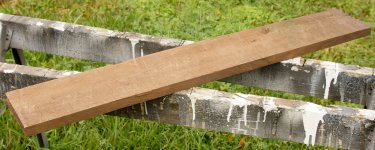 DSC07808.jpg813.7 KB · Views: 254
DSC07808.jpg813.7 KB · Views: 254 -
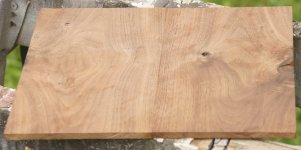 DSC07822.jpg984.7 KB · Views: 70
DSC07822.jpg984.7 KB · Views: 70 -
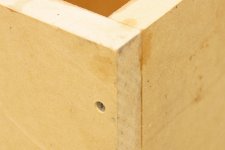 DSC07818.jpg491.3 KB · Views: 73
DSC07818.jpg491.3 KB · Views: 73 -
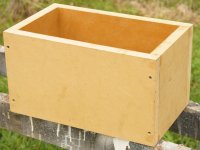 DSC07821.jpg530.8 KB · Views: 71
DSC07821.jpg530.8 KB · Views: 71 -
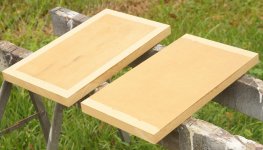 DSC07813.jpg884.5 KB · Views: 65
DSC07813.jpg884.5 KB · Views: 65 -
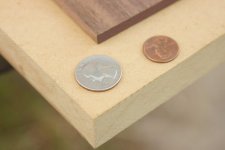 DSC08605.jpg347.2 KB · Views: 58
DSC08605.jpg347.2 KB · Views: 58 -
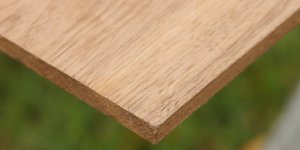 DSC07817.jpg346.7 KB · Views: 63
DSC07817.jpg346.7 KB · Views: 63 -
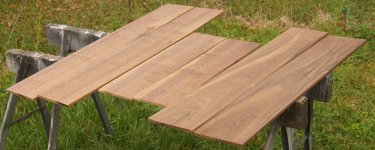 DSC07815.jpg739.4 KB · Views: 65
DSC07815.jpg739.4 KB · Views: 65 -
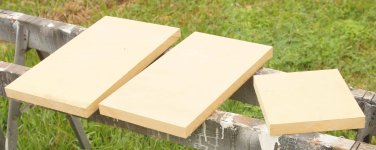 DSC07811.jpg664 KB · Views: 62
DSC07811.jpg664 KB · Views: 62 -
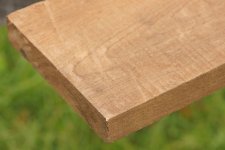 DSC07810.jpg607.3 KB · Views: 73
DSC07810.jpg607.3 KB · Views: 73
It turns out that the binding posts that I'm using won't work with speaker walls thicker than 1 inch, so I only used walnut on five sides instead of six and I used Formica on the back. In hindsight, I should have used 3/4-inch MDF on the back instead of 1-inch. Anyway, here are the rest of the pictures:The only thing I have left to do is cut/drill the holes for the speakers, the port and the binding posts. Here are some pictures that I took along the way:
Attachments
-
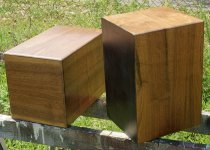 DSC09602.jpg944.6 KB · Views: 88
DSC09602.jpg944.6 KB · Views: 88 -
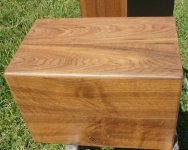 DSC09603.jpg710.8 KB · Views: 69
DSC09603.jpg710.8 KB · Views: 69 -
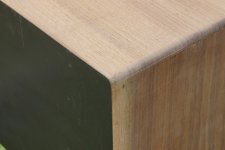 DSC08630.jpg598.5 KB · Views: 71
DSC08630.jpg598.5 KB · Views: 71 -
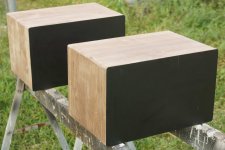 DSC08626.jpg536.2 KB · Views: 68
DSC08626.jpg536.2 KB · Views: 68 -
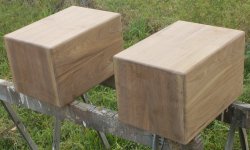 DSC08632.jpg901.1 KB · Views: 66
DSC08632.jpg901.1 KB · Views: 66 -
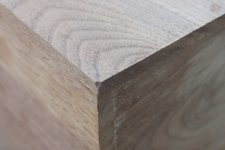 DSC08620.jpg339.7 KB · Views: 66
DSC08620.jpg339.7 KB · Views: 66 -
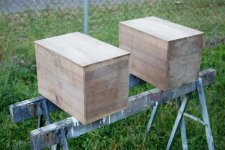 DSC08616.jpg615.8 KB · Views: 68
DSC08616.jpg615.8 KB · Views: 68 -
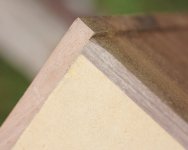 DSC08613.jpg602.8 KB · Views: 68
DSC08613.jpg602.8 KB · Views: 68 -
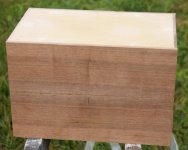 DSC08615.jpg675.2 KB · Views: 72
DSC08615.jpg675.2 KB · Views: 72 -
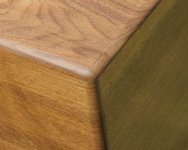 DSC09608.jpg841.2 KB · Views: 99
DSC09608.jpg841.2 KB · Views: 99
Exactly. You can buy commercial jack plates or cups from places like Parts Express.
That makes sense to me, but if you are into wood work, you could also use a router to make a cup in the wood. Mill out space for the two posts down to maybe half the thickness of the panel.
An example:
Round Speaker Terminal 2-7/8" Gold Spring-Loaded 260-276
They come in round or square, with spring loaded or banana posts, etc.
That makes sense to me, but if you are into wood work, you could also use a router to make a cup in the wood. Mill out space for the two posts down to maybe half the thickness of the panel.
An example:
Round Speaker Terminal 2-7/8" Gold Spring-Loaded 260-276
They come in round or square, with spring loaded or banana posts, etc.
- Status
- This old topic is closed. If you want to reopen this topic, contact a moderator using the "Report Post" button.
- Home
- Design & Build
- Construction Tips
- Discussion on what materials to build speakers out of
